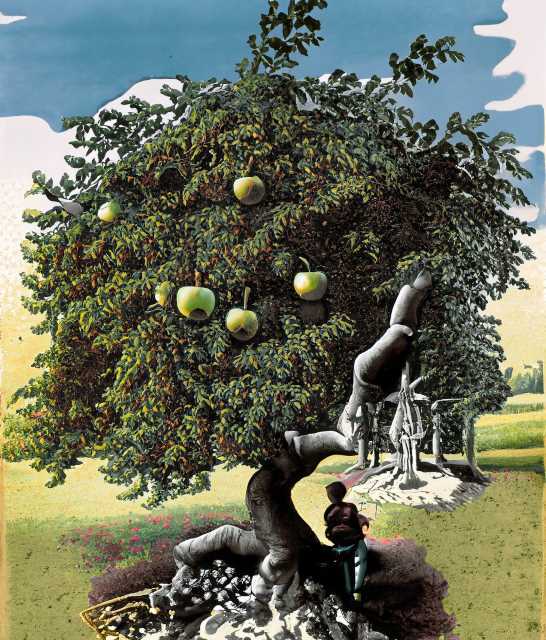How Sir Isaac Newton's Apple Became an Icon of Science
Unraveling the truth behind Newton's apple: Explore the real story and context of this iconic moment. Discover the evolution of his ideas and the legacy of his groundbreaking contributions to science.

In the annals of scientific history, few stories have captured the imagination quite like the tale of Sir Isaac Newton and the falling apple. It is a legend that has been passed down through generations, captivating the minds of both young and old alike. But behind the myth lies a more nuanced and fascinating reality, one that offers a deeper understanding of Newton's revolutionary contributions to physics and the development of scientific knowledge.
The Plague and Newton's Retreat
To appreciate the significance of Newton's apple, we must first delve into the circumstances that led to this pivotal moment. In 1665, the bubonic plague swept across London, forcing Trinity College in Cambridge to send its students home to protect them from the contagion. Among these students was Newton, who retreated to the tranquility of his family farm in Woolsthorpe.
This period of isolation, lasting approximately two years, would come to be recognized as Newton's most productive phase. Freed from the distractions of university life, he immersed himself in intellectual pursuits, laying the groundwork for his groundbreaking discoveries.
The Fall of the Apple and Gravity
It was during this time, amid the quiet solitude of his orchard, that the event commonly associated with the apple occurred. While the exact details may have been embellished over time, the essence of the story remains: Newton witnessed the fall of a ripe apple from a tree, triggering a profound insight in his mind.
Contrary to popular belief, Newton did not conclude from this single observation that the Moon falls in the same manner as the apple. Rather, the apple catalyzed his thoughts on the fundamental forces governing celestial motion. It sparked his realization that the force responsible for the apple's descent might extend beyond Earth, reaching as far as the Moon.
Newton's Groundbreaking Law
Newton's revelation did not materialize instantaneously, nor did it culminate in a fully formed law. It was the beginning of a journey that would ultimately lead to the development of his revolutionary law of universal gravitation. Newton dedicated years of meticulous study, research, and mathematical formulation to refine and articulate his ideas.
The law of universal gravitation, published in his seminal work "Philosophiæ Naturalis Principia Mathematica" in 1687, states that every object in the universe attracts every other object with a force directly proportional to their masses and inversely proportional to the square of the distance between them. This law provided a comprehensive explanation for the motions of celestial bodies, including the Moon's orbit around Earth.
The Distortion of the Scientific Process
The legend of Newton's apple, though captivating, oversimplifies the scientific process and obscures the true magnitude of Newton's contributions. Science is rarely born out of singular moments of revelation but is rather the result of collective efforts, painstaking research, and iterative progress over time.
Unfortunately, this distortion can lead to misunderstandings and misconceptions. While many may recall the apple story, a significant number may struggle to comprehend the underlying physics or the broader context of Newton's work. It is crucial to explore beyond the legend and delve into the intricacies of Newton's discoveries to grasp the full extent of his scientific achievements.

The Influence of Contemporary Scientists
Newton was not working in isolation; he was deeply influenced by the scientific knowledge of his time. Scholars such as Galileo Galilei and Johannes Kepler made significant contributions to the understanding of motion and celestial mechanics. Newton built upon their work and incorporated it into his framework.
Furthermore, it is worth noting that Newton's apple was not the only impetus behind his breakthroughs. His rigorous study of mathematics, experimentation with prisms and light, and engagement with a wide range of scientific disciplines all played crucial roles in shaping his ideas. It is the combination of these factors that propelled Newton's genius and allowed him to make such profound contributions to science.
To truly appreciate Newton's apple and its significance, it is important to consider alternative explanations and theories that were prevalent at the time. While Newton's law of universal gravitation provided a comprehensive and elegant explanation for celestial motion, other hypotheses existed.
One such hypothesis was the concept of "impetus" proposed by Jean Buridan and further developed by Nicole Oresme in the 14th century. According to this theory, celestial bodies were thought to possess an inherent impetus that kept them in motion. It was a precursor to the idea of inertia, which Newton later refined and incorporated into his laws of motion.
By examining these alternative explanations, we gain a deeper appreciation for the complexity and evolution of scientific thought. It underscores the significance of Newton's contributions, as he not only refined existing ideas but also synthesized them into a comprehensive and mathematically rigorous framework.
Newton's Enduring Legacy
While the story of Newton's apple serves as a captivating entry point into his world of scientific discovery, it is essential to move beyond the legend and explore the broader legacy of his work. Newton's laws of motion and his law of universal gravitation laid the foundation for classical mechanics and revolutionized our understanding of the physical world.
Moreover, Newton's groundbreaking insights extended far beyond the realm of physics. His work on calculus, optics, and the nature of light solidified his reputation as one of history's greatest scientific minds. His contributions continue to shape a wide range of disciplines to this day, from astronomy and engineering to mathematics and even space exploration.
Conclusion
The tale of Newton's apple, while captivating and emblematic of scientific inspiration, should not overshadow the depth and complexity of Newton's contributions to the field of physics. The apple catalyzed his thoughts, but it was the years of dedicated study and intellectual rigor that led to the development of his laws of motion and the law of universal gravitation.
By exploring the broader context of Newton's work, the influence of contemporary scientists, and alternative explanations, we gain a more accurate understanding of the scientific process and the true magnitude of Newton's genius. The story of the apple may endure as a symbol of scientific discovery, but it is through a comprehensive exploration of Newton's work that we truly appreciate his lasting impact on the world of science.




